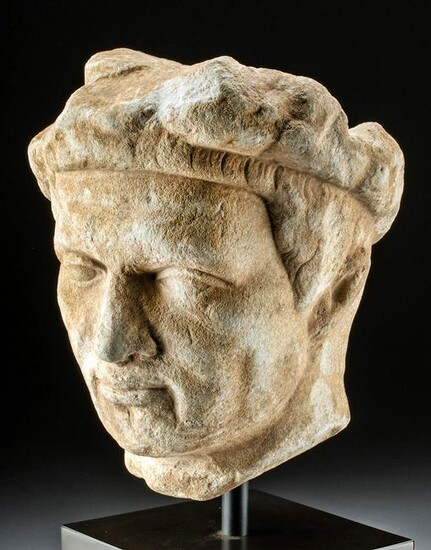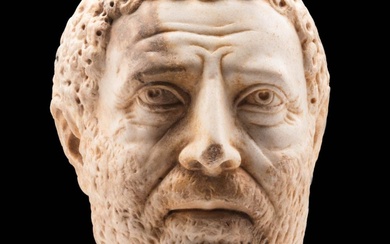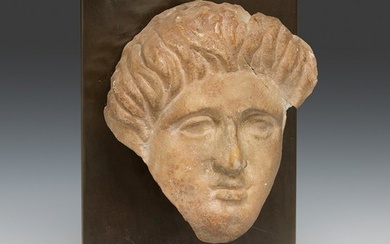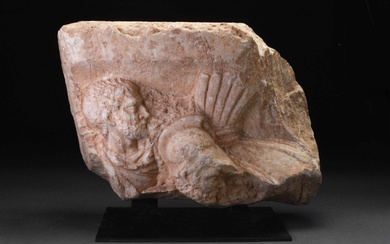Roman Marble Head of a Man Wearing a Wreath
Rome, Imperial Period, ca. 1st to 4th century CE. An exceptional marble head of a man, expertly sculpted with fine detail to appear lifelike. Capped with a thick coiffure and sizeable laurel wreath, the ancient figure gazes outwards from generously-lidded eyes above a broad nose and thin lips held in a slight smile. A pair of naturalistically carved ears flank his noble visage. Note the exemplary skill of the artist to render flesh from stone as evident in the sculpture's prominent nasolabial folds, sunken cheeks with defined cheek bones, and wrinkled brow. Size: 10.5" L x 10.5" W x 11.3" H (26.7 cm x 26.7 cm x 28.7 cm); 18.5" H (47 cm) on included custom stand.
This individual was most likely a soldier in the Imperial Roman army, as wreaths were awarded for military achievements during the Imperial period; the oak leaf civic crown was earned by saving the life of another citizen, the gold wreath was granted for gallant military conduct, the naval crown was awarded for feats in naval battles, and the mural crown was vested upon the first man onto the walls of the enemy fortification.
In the Classical world, portraiture served two main functions - all depended upon whether the subject was dead or alive. Images of the deceased were created for ancestral worship and kept in a private or family context. Ancestral busts preserved the individual's contributions and legitimized the family line. Sometimes masks of important ancestors were worn at funeral processions. Images of the living, on the other hand, were placed in public contexts, as a means of commemorating the individual's might, oftentimes honoring a military victory or public benefaction. For example, sculptures of Augustus and successive emperors served to advertise and affirm their power.
Classical Greeks and the Romans who came after them honored notable individuals by sculpting them in marble, often with the intention of placing the sculpture at their tombs. While the Greeks frequently portrayed their subjects as idealized and youthful, the Romans focused more on true physical characteristics. Their attention to details of dress, countenance, and coiffure indicated their subjects' social and political statuses. The realistic proportions of this face suggest that the sculptor revered mathematically based proportions in his creations, much like the revered Greek sculptor Polykleitos who purportedly exclaimed, "Perfection comes about little by little through many numbers." Notice the attention to even the smallest details, i.e., the precise delineation of the fine facial contours around the mouth and cheeks.
This piece has been searched against the Art Loss Register database and has been cleared. The Art Loss Register maintains the world's largest database of stolen art, collectibles, and antiques.
Provenance: East Coast collection, New York Gallery, New York City, New York, USA, before 2010
All items legal to buy/sell under U.S. Statute covering cultural patrimony Code 2600, CHAPTER 14, and are guaranteed to be as described or your money back.
A Certificate of Authenticity will accompany all winning bids.
PLEASE NOTE: Due to recent increases of shipments being seized by Australian & German customs (even for items with pre-UNESCO provenance), we will no longer ship most antiquities and ancient Chinese art to Australia & Germany. For categories of items that are acceptable to ship to Australia or Germany, please contact us directly or work with your local customs brokerage firm.
Display stands not described as included/custom in the item description are for photography purposes only and will not be included with the item upon shipping.
#159396
Condition Report: Fragment of a larger piece. Losses to top of coiffure and wreath. Repair and restoration to nose. Some expected surface wear with nicks and abrasions, commensurate with age. Drill hole in base to attach to custom stand. Otherwise, excellent with impressive preservation of detail and light earthen deposits in areas. Some loosening of panels on custom stand.
View it on
Estimate
Time, Location
Auction House
Rome, Imperial Period, ca. 1st to 4th century CE. An exceptional marble head of a man, expertly sculpted with fine detail to appear lifelike. Capped with a thick coiffure and sizeable laurel wreath, the ancient figure gazes outwards from generously-lidded eyes above a broad nose and thin lips held in a slight smile. A pair of naturalistically carved ears flank his noble visage. Note the exemplary skill of the artist to render flesh from stone as evident in the sculpture's prominent nasolabial folds, sunken cheeks with defined cheek bones, and wrinkled brow. Size: 10.5" L x 10.5" W x 11.3" H (26.7 cm x 26.7 cm x 28.7 cm); 18.5" H (47 cm) on included custom stand.
This individual was most likely a soldier in the Imperial Roman army, as wreaths were awarded for military achievements during the Imperial period; the oak leaf civic crown was earned by saving the life of another citizen, the gold wreath was granted for gallant military conduct, the naval crown was awarded for feats in naval battles, and the mural crown was vested upon the first man onto the walls of the enemy fortification.
In the Classical world, portraiture served two main functions - all depended upon whether the subject was dead or alive. Images of the deceased were created for ancestral worship and kept in a private or family context. Ancestral busts preserved the individual's contributions and legitimized the family line. Sometimes masks of important ancestors were worn at funeral processions. Images of the living, on the other hand, were placed in public contexts, as a means of commemorating the individual's might, oftentimes honoring a military victory or public benefaction. For example, sculptures of Augustus and successive emperors served to advertise and affirm their power.
Classical Greeks and the Romans who came after them honored notable individuals by sculpting them in marble, often with the intention of placing the sculpture at their tombs. While the Greeks frequently portrayed their subjects as idealized and youthful, the Romans focused more on true physical characteristics. Their attention to details of dress, countenance, and coiffure indicated their subjects' social and political statuses. The realistic proportions of this face suggest that the sculptor revered mathematically based proportions in his creations, much like the revered Greek sculptor Polykleitos who purportedly exclaimed, "Perfection comes about little by little through many numbers." Notice the attention to even the smallest details, i.e., the precise delineation of the fine facial contours around the mouth and cheeks.
This piece has been searched against the Art Loss Register database and has been cleared. The Art Loss Register maintains the world's largest database of stolen art, collectibles, and antiques.
Provenance: East Coast collection, New York Gallery, New York City, New York, USA, before 2010
All items legal to buy/sell under U.S. Statute covering cultural patrimony Code 2600, CHAPTER 14, and are guaranteed to be as described or your money back.
A Certificate of Authenticity will accompany all winning bids.
PLEASE NOTE: Due to recent increases of shipments being seized by Australian & German customs (even for items with pre-UNESCO provenance), we will no longer ship most antiquities and ancient Chinese art to Australia & Germany. For categories of items that are acceptable to ship to Australia or Germany, please contact us directly or work with your local customs brokerage firm.
Display stands not described as included/custom in the item description are for photography purposes only and will not be included with the item upon shipping.
#159396
Condition Report: Fragment of a larger piece. Losses to top of coiffure and wreath. Repair and restoration to nose. Some expected surface wear with nicks and abrasions, commensurate with age. Drill hole in base to attach to custom stand. Otherwise, excellent with impressive preservation of detail and light earthen deposits in areas. Some loosening of panels on custom stand.







